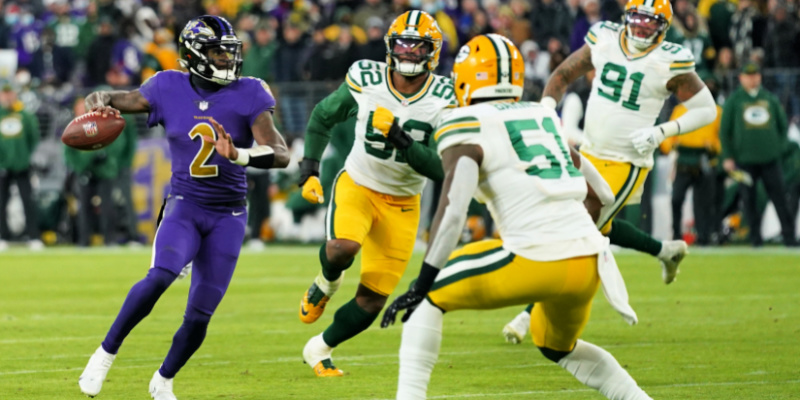Breakdowns
1/19/22
6 min read
Playing To Win: Why Going For 2 Down 8 Is The Right Call

31-30. The Baltimore Ravens, without QB Lamar Jackson, have just scored what could be the game-tying TD against the NFL best 10-3 Green Bay Packers. The Ravens, however, are not kicking the extra point; they’re going for 2 to win the game.
Tyler Huntley rolls right and passes to star tight end Mark Andrews who had carved up the Packers on that TD drive, but alas the pass falls incomplete. The Ravens lose the game and the blame falls on John Harbaugh and his use of “analytics.” While the analytics did suggest that going for 2 at that moment was the correct decision, Harbaugh made a key analytical mistake earlier, failing to maximize their win probability.
If we go back to when the score was 31-17 with 8 minutes left to go, the chances of the Ravens winning looked bleak, but Tyler Huntley put together a 12 play/75 yard drive to give the Ravens hope. At this point, they kicked the extra point and cut it to 31-24, which was a major analytical mistake.
To many, kicking the PAT may seem like the obvious decision. Of course you kick the PAT because if you score another TD, you can decide to kick or go for 2 at that point. But in actuality, it is more advantageous to go for 2 when you’re down 8.
Let’s start by comparing the chance of winning if you kick the PAT down 8 and go for 2 down 1 (like Harbaugh did) vs. going for 2 down 8 and adjusting from there.
First, let’s assume league average conversion rates over the last 5 years (obviously it’s not league average but since the same probabilities are used in the other scenarios, it doesn’t affect the math) of a 93.7% PAT rate and a 47.2% 2 pt conversion rate. Let’s look at what happens if the team is able to score the next TD without conceding additional points because in all scenarios where doesn’t that happen, the game ends and the decision down 8 is meaningless.
In Harbaugh’s scenario, the way to win is to make the PAT and then convert the 2 pt conversion. That would mean the Ravens would have a .937*.472 = 44% chance of winning in regulation assuming they score a 2nd TD. They also have a chance of tying in regulation with a PAT miss and a 2 pt conversion. This is a (1-.937)*.472 = 3% chance of the game being tied in regulation assuming a 2nd TD. All other scenarios result in a loss so the Ravens would have a 1-.44-.03 = 53% chance of losing the game in regulation.
If the Ravens would have gone for 2, there are more possibilities. They can win by converting the 2 pt attempt and kicking the PAT the second time. That would be .472*.937 = 44% chance of winning in regulation assuming a 2nd TD. They would tie in regulation by not converting the first time but converting the second time. That’s a (1-.472)*.472 = 25% chance of sending the game to OT assuming a 2nd TD. Anything else is a loss, which would be a 1-.44-.25 = 31% chance of losing in regulation assuming a 2nd TD.
| Decision Down 8 | Chance of Win | Chance of OT | Chance of Loss |
| Go For 2 Down 8 | 44% | 25% | 31% |
| Kick PAT, Go For 2 Down 1 | 44% | 3% | 53% |
As you can see here, Harbaugh's decision did nothing except for reducing the chance of a tie and instead converting that probability into losing in OT.
The reason for this is that going for 2 when down 8 allows you to see if you converted or not and adjust your decision the next time. Because of this, going for 2 down 8 is superior to going for 2 down 1.
Clearly Harbaugh is a smart coach, and there must have been some reason for him not going for 2 down 8. Some speculate that he wasn’t confident in Huntley’s ability to convert the 2 point conversion initially and planned on kicking 2 PATs. But after seeing him light up the Packers on the final drive, he was convinced to follow the analytics at that point and go for 2. While this line of thinking could make sense, it’s still flawed because for the conversion to matter, the Ravens needed to score the 2nd TD anyway. If that’s enough to give Harbaugh the confidence boost to go for it, he should’ve gone for it down 8.
Now, let’s get to the final scenario of comparing going for 2 down 8 with the conservative play call of kicking 2 extra points and playing for OT.
Joey DiCresce recently wrote a piece on going for 2 down 1 vs. kicking an extra point to send the game into OT.
In his piece, he essentially concluded that underdogs should go for 2, while favorites should kick the PAT. We’ve also already established that going for 2 down 8 is more beneficial than going for 2 down 1.
Assuming a team kicks 2 PATs, they can’t win in regulation (i.e. they would have a 0% chance of winning in regulation). Instead, they would send the game to OT by making both PATs, so that’s .927*.927 = 86% chance of tying the game with 2 made PATs assuming a 2nd TD. They could also tie if they miss their first PAT but convert a 2 pt try on the 2nd attempt which comes out to a total .86 + (1-.927)*.472 = 89.5% chance of sending the game into OT assuming a 2nd TD. That would leave a 1-.895 = 10.5% chance of losing in regulation assuming a 2nd TD.
| Decision Down 8 | Chance of Win | Chance of OT | Chance of Loss |
| Go For 2 Down 8 | 44% | 25% | 31% |
| Kick PAT, Go For 2 Down 1 | 44% | 3% | 53% |
| Kick Pat Twice | 0% | 89.5% | 10.5% |
Now at this point, we can find the odds of winning in OT needed to justify kicking 2 PATs instead of going for 2 down 8.
The chance of winning going for 2 down 8 can be represented by 0.44 + 0.25*OT, and the chance of winning by kicking 2 PATs can be represented by 0 + .895*OT.
The inequality 0.44 + 0.25*OT < .895*OT simplifies to 0.44 < .895OT-.25OT and then further to .44 < .645*OT. We can evaluate and figure out that to justify kicking 2 PATs, the team would need to have a .44/.645 = 68% chance of winning in overtime. Even if the team is the favorite, and we assume they get the ball first in overtime, teams on average still have less than a 59% chance of winning the game.
By not deciding to go for 2 when they’re down 8, teams are forfeiting 10% of win probability in the best case scenario assuming the 2nd TD. This is inexcusable in today’s NFL. It is clearly the right decision to go for 2, but until teams and coaches change their mindset, they’re going to keep handicapping their chances of winning games.








